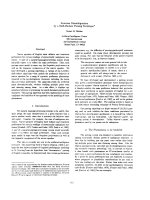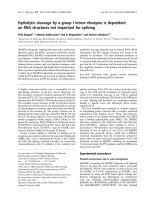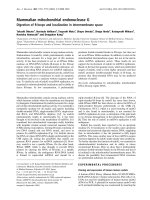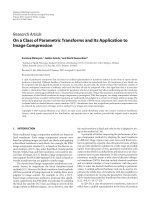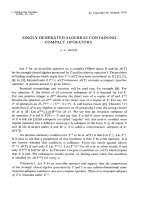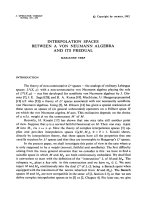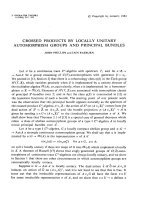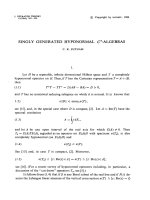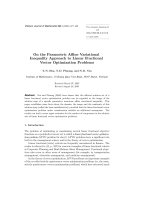Báo cáo toán học: "Permutations generated by a stack of depth 2 and an infinite stack in series" potx
Bạn đang xem bản rút gọn của tài liệu. Xem và tải ngay bản đầy đủ của tài liệu tại đây (112.67 KB, 12 trang )
Permutations generated by a stack of
depth 2 and an infinite stack in series
Murray Elder
Department of Mathematics,
Stevens Institute of Technology, Hoboken NJ USA
/>
Submitted: Oct 17, 2005; Accepted: Jul 31, 2006; Published: Aug 7, 2006
Mathematics Subject Classification: 05A05
Abstract
We prove that the set of permutations generated by a stack of depth two and an
infinite stack in series has a basis (defining set of forbidden patterns) consisting of
20 permutations of length 5, 6, 7 and 8. We prove this via a “canonical” generating
algorithm.
1 Introduction
In this article we examine the set of permutations that can be generated by passing the
sequence 1, 2, ,nthrough a stack of depth two followed by an infinite stack, as in Figure
1. The depth of a stack is the number of tokens it can hold, including one space at the
top for passing tokens through the stack. By convention we pass tokens right to left.
We prove in Theorem 9 that a permutation can be generated in this way if and
only if it avoids a list of sub-patterns of 20 permutations, and furnish a deterministic
procedure (Algorithm 4) for generating them. These permutations were found initially
by computations with a stack of depth two and a stack of depth k for increasing k by
Linton [6].
The current interest in permutations that avoid sub-patterns could perhaps be traced
back to Knuth, who proved that a permutation can be generated by passing an ordered
sequence though a single infinite stack if and only if it avoids the subsequence 3, 1, 2[5]
1
.
For two infinite stacks in series, the set of avoided minimal sub-patterns that charac-
terize the permutations that can be generated is infinite [7]. But somewhere between a
1
Actually he proved the equivalent fact that a permutation can be sorted if and only if it avoids 2, 3, 1.
He also showed that they are enumerated by the Catalan numbers.
the electronic journal of combinatorics 13 (2006), #R68 1
A
B
1 2 3 4 5
A
B
1
2 3 4 5
3 4 5
A
B
1
2
Apply rule 1.2 Apply rule 3.1
4 5
A
B
3
1
2
5
A
B
3
1
4
2
5
A
B
3
1
4
2
Apply rule 2.2
5 2
A
B
3
1
4
5 2 3
A
B
1
4
A
B
4
5 2 3 1
Figure 1: Generating the permutation 52314.
first stack of depth one (ie. no first stack) and infinite depth, there is a break point where
the basis goes from being finite to infinite (see Lemma 1).
A good overview of permutations generated and sorted in various ways using stacks
can be read in [3] and a good introduction to the field of pattern avoiding permutations
can be found in [2]. Recent open problems in the field are summarized in [4].
The article is organized as follows. In Section 2 we define permutations and pattern
avoidance, and give some basic facts and terminology for permutations generated by
stacks. In Section 3 we describe an algorithm to decide whether or not a given permutation
can be generated using a stack of depth two followed by an infinite stack. We prove that
the algorithm is valid, and that a permutation is accepted if and only if it can be generated
by the stacks, if and only if it avoids the 20 permutations.
the electronic journal of combinatorics 13 (2006), #R68 2
2 Preliminaries
A permutation is an arrangement of a finite number of distinct elements of a linear order,
for example, 5, 1, 2, 4, 3or4, 6, 1. It is customary to omit the commas and write 51243.
Two permutations are order isomorphic if they have the same relative ordering. So 231
and 461 are order isomorphic. Define a sub-permutation of a permutation p
1
p
n
to be
awordp
i
1
p
i
s
with i
1
< <i
s
.Asubinterval of a permutation is a sub-permutation
consisting of contiguous entries, that is, i
j+1
= i
j
+1 for j =1, ,s−1. A permutation p
contains or involves a permutation q if it has a sub-permutation that is order isomorphic
to q.Sop = 51243 contains q = 321 since deleting the entries 1 and 2 of p gives the
sub-permutation 543 which is order isomorphic to q.Apermutationp avoids q if it does
not contain it. So 51243 avoids the permutation 231 since no sub-permutation is order
isomorphic to 231.
A set of permutations S is said to be closed (under involvement) if p ∈ S and p
involves or contains q implies that q ∈ S. Given a set of permutations B,thesetAv(B)
of permutations which do not contain any permutations from B is closed, and is called
the avoidance set for B. If a set of permutations can be described as the avoidance set
for some set B,andB is the minimal such set (so that no element of B contains another)
then we call B the basis for the set. For example, the set of permutations that avoid 12
and 123 is the set of all decreasing permutations, and its basis is simply {12}.Notealso
that if σ is in a basis for a set S then deleting any entry of σ gives a permutation that is
order isomorphic to an element of S.
Define S
k,∞
to be the set of permutations that can be generated by passing 1 n
through a stack of depth k followed by an infinite stack, and define B
k,∞
as its basis. So
for example, the basis for a stack of depth one (so no storage) followed by an infinite stack
is {312}. We will call the input symbols letters or tokens.
Lemma 1 Let σ ∈ B
k,∞
and define σ
3
to be the string of integers obtained by adding
three to the value of every entry of σ. Either σ or σ
3
213 is in B
k+1,∞
.
Proof: If σ is not in S
k+1,∞
then, since deleting any entry of σ gives a permutation that is
in S
k,∞
⊆ S
k+1,∞
, it follows that σ ∈ B
k+1,∞
. So we can assume that σ is in S
k+1,∞
.Now
consider the problem of generating σ
3
213. Whichever way you put the tokens 1, 2and3
onto the two stacks, some token must occupy the first stack. These tokens must stay until
the rest of the permutation has been output, so the remaining tokens must be processed
with the first stack of depth k rather than k + 1. But since σ cannot be generated with
the first stack of depth k then neither can σ
3
,soσ
3
213 is not in S
k+1,∞
.
To show that σ
3
213 is a basis element, we must show that every shorter permutation
contained in it is in S
k+1,∞
.Letτ be a sub-permutation of σ
3
213 obtained by deleting
one entry. If τ = σ
3
21,σ
3
23 or σ
3
13 then we can generate it as follows. Place the first two
entries (1, 2), (1, 3) or (2, 3) on the second stack in the appropriate order. This leaves the
first stack clear, so we can now generate σ
3
using the two stacks (since σ ∈ S
k+1,∞
), and
lastly output the two tokens. If instead τ has an entry deleted from the σ
3
prefix, then we
place tokens 1, 2 on the second stack with 2 on top, and leave 3 on the first stack. Since σ
the electronic journal of combinatorics 13 (2006), #R68 3
length 5 51234 52134 length 7 4175623 4275613
51243 52143 4137256 4237156
51423 52413 4137265 4237165
length 6 645123 645213 length 8 41386725 42386715
416235 426135
416253 426153
Table 1: The set B.
was in the basis for S
k,∞
, we can generate σ
3
with one entry deleted while the first stack
has depth k, and then we can output 213. Thus we can generate any sub-permutation of
σ
3
213.
It follows that for all n ∈ N, |B
k,∞
|≤|B
k+1,∞
|. Since by Theorem 9 B
2,∞
is finite,
then either there is a number n>2 such that B
k,∞
is finite for all k ≤ n and not finite
for k>n,orB
n,∞
could be finite for all n ∈ N.
Define B to be the following set of 20 permutations in Table 1. Observe that B is
closed under the operation of interchanging the 1 and 2 entries.
Lemma 2 If a permutation contains an element of B then it cannot be generated by a
stack of depth 2 followed by an infinite stack.
Proof: It suffices to prove that none of the permutations in B can be generated by the two
stacks. It then follows that no permutation containing one can be generated. It is routine
to check by hand or computer that each of the permutations in B cannot be generated
by a stack of depth two followed by an infinite stack. We can enumerate the full list of
permutations of length up to 8 generated by considering codewords on three letters ρ, λ, µ
that correspond to pushing tokens from input to the first stack (ρ), from the first to the
second stack (λ), then output (µ). For example, the codeword ρλµρλµρλµ generates the
permutation 123. We require that each prefix must have no more λsthanρs, no more
µsthanλs, and further that the number of ρs is no more than 2 plus the number of λs.
Using this technique we can verify that none of the permutations in B are produced. .
Linton conjectured that this set should be the basis for S
2,∞
. In [1] Aktinson et al
consider the set of permutations generated by passing 1 nthrough a finite token passing
network, which is a directed graph where nodes can hold at most one token, and tokens
move in any way from an input to an output node. One can view two stacks in series as
a token passing network, which is finite if both stacks are of bounded depth. They prove
that the set of permutations generated via finite networks can be encoded in a regular
language, and from this one can find its basis. Using an implementation of this procedure
in GAP Linton [6] computed the bases for S
2,k
for increasing k, and observed that in each
case 20 small permutations occurred, as well as longer permutations which related to the
bound on the second stack. Linton conjectured that in the limit the basis should consist
of just these elements.
In proving this conjecture we will make use of the following technical definitions. Let us
say that a subinterval τ of a permutation σ = ατβ is right-contiguous if β does not contain
the electronic journal of combinatorics 13 (2006), #R68 4
any entries between the minimum and maximum entries in τ ,andisright-contiguous
modulo a if β does not contain any entries between the minimum and maximum entries
in τ except the entry a. For example, the subinterval 413 of 4137256 is right contiguous
modulo 2 and 137 is not.
Lastly, we will make use of the following notation for permutations below. If a per-
mutation contains a token a preceding a token b, then we write −a − b−,orsimplya − b,
when we do not know the other letters of the permutation. The notation a<
b
c
means that
we know the permutation contains an a preceding both b and c, but we do not know the
relative orderings of the b and c. That is, the permutation could be a − b − c or a − c − b.
For example, every permutation of length 5 in Table 1 except 52413 is of the form 5 <
1−4
2
.
3 The algorithm
In this section we describe a deterministic procedure to generate permutations using a
depth two followed by an infinite stack in series. Denote the stack of depth two stack as A
and the infinite stack as B. Without loss of generality if there are input letters remaining
then A contains an entry a.Thatis,ifA ever becomes empty then we will immediately
fill it with the next input letter.
Let x be the next input letter, and b be the top entry of B (if non-empty). The stack
B is well ordered if its elements are stacked from top to bottom in order they appear in
the permutation generated.
If b, a or x are next to be output, then output, and move the next input letter into A
if empty. If the next output letter is below b then the permutation cannot be generated
(by the algorithm being used). Otherwise the next output letter is y somewhere back in
the input list. See Figure 2.
x y
A
B
a
b
Figure 2: Algorithm
We will choose between pushing a to stack B and x to stack A, or vice versa, using
the following (fairly technical) rules.
Rules 3 If y is the next token to be output, x precedes it in the input stream, a is on
stack A and b is at the top of stack B (if non-empty), then:
the electronic journal of combinatorics 13 (2006), #R68 5
1.1. If in the output permutation a precedes some two letters in the input that lie between
x and y, then keep a on stack A and put x on stack B.
1.2. If in the output permutation x precedes some two letters in the input that lie between
x and y, then put x on A and a on B.
2.1. If in the output permutation b precedes a then keep a on A and put x on B.
2.2. If in the output permutation b precedes x then put x on A and a on B.
When none of the conditions for 1.1-2.2 are met, then:
3.1. If in the output permutation a precedes x then keep a on A and put x on B unless
the subinterval y a is right-contiguous modulo x and avoids 312, in which case
put a on B and x on A.
3.2. If in the output permutation x precedes a then put a on B and x on A unless the
subinterval y x is right-contiguous and avoids 312, in which case keep a on A and
put x on B.
If the conditions of a rule are met, we say that the rule applies. It may happen
that at some point while pushing tokens around the stacks, two or more rules apply
simultaneously. For example, to generate the permutation 51234, we would put 1 on
stack A,thena =1,x =2andy = 5. In this case, both rules 1.1 and 1.2 apply. See
Figure 3. If this is the case then any algorithm we construct using these rules will halt.
A
B
1 2 3 4 5
A
B
1
2 3 4 5
Both 1.1,1.2 apply
Figure 3: Generating the permutation 51234.
We now state the algorithm.
Algorithm 4 Given a permutation of length n, to produce it by passing an ordered se-
quence through the stacks, do the following. Define I to be the input list, and initialize it
to 1, ,n. While I = ∅ do:
1. If the top letter of I,A or B is next output letter, then output.
2. Else if A = ∅ then place next input letter on A.
the electronic journal of combinatorics 13 (2006), #R68 6
3. Else apply Rules 3. If two contradictory rules apply, then reject.
When I = ∅ then accept.
For example, in Figure 1 we generate 52314 by using rules 1.2 for step two, 3.1 for
step three, and 2.2 for step four. The remaining steps simply offload the next tokens to
be output.
To generate the permutation 4132 we keep 1 on stack A and pass 2 to stack B,since
the subinterval 41 does not contain 3 so is not right-contiguous modulo 2. We show this
in Figure 4.
A
B
1
2 3 4
3 4
A
B
2
1
3
A
B
2
1
4
Apply rule 3.1 Apply rule 3.1 Apply rule 3.1
Figure 4: Generating the permutation 4132.
As another example, consider the permutation 316245. If you were to keep 1 on stack
A and pass 2 over to stack B (contrary to rule 3) you would not succeed. The steps
dictated by rules 1-3 are used in Figure 5. Compare the two applications of rule 3.1.
We will prove that if the permutation being generated avoids B, then no two contra-
dictory rules ever apply, and in this case that each rule preserves the well ordering of B.
Therefore if a permutation is in Av(B) then it can be generated using this algorithm.
Lemma 5 If no two rules apply simultaneously then each move keeps the stack B well
ordered.
Proof: If rule 2.1 applies then there is a b on B that precedes a, but does not precede
x or rule 2.2 would also apply. Similarly, if rule 2.2 applies then there is a b on B that
precedes x, but does not precede a or rule 2.1 would also apply. In either case the token
that goes on B precedes the token b. If neither rules 2.1 or 2.2 apply then a and x both
precede all tokens that may be on B, so we can place either on B, as directed by a rule
1.1, 1.2, 3.1 or 3.2, and B will remain well ordered.
Lemma 6 If a configuration where c is the top entry of B and A is momentarily empty
(before the next input letter fills it) is reached part way through producing an output
permutation σ, where no two contradictory rules applied up to this point, then σ has a
sub-permutation which is order isomorphic to 4132 or 4231.
the electronic journal of combinatorics 13 (2006), #R68 7
A
B
1
2 3 4 5 6
3 4 5 6
A
B
1
2
A
B
1
2
3
4 5 6
Apply rule 3.1
3 1
A
B
2
4 5 6
5 6
A
B
2
4
3 1
6
A
B
4
5
2
3 1
Apply rule 3.1 Apply rule 2.2
Figure 5: Generating the permutation 316245.
Proof: Consider the point at which c is placed on stack B. Some rule must have applied,
with c either next to be input with some d on stack A, or vice versa, and some token z
in the input the next to be output in the permutation. The output is z − d − c since we
must get to the configuration with c on B and A empty.
If rule 1 applied then there must be p, q in the input before z and output as z−d−p<
q
c
.
So taking z =4,p=3andc =1,d=2ord =1,c=2weget4d3c.
If rule 2 applied to put c on B and d on A then there must be some e on B with
the output of the form z − c − e − d, but d must be output before c to get the required
configuration. So this is a contradiction.
If neither rules 1 or 2 apply, then since d precedes c in the output, rule 3 tell us to put
d on stack A unless z d is right-contiguous modulo c and avoids 312. Since d is kept
on A while c goes on B, we conclude that these conditions were not met.
If z d fails to be right-contiguous because of some p input after c and d and before
z and output after d then we have output z − d − p − c since p must be output before
the configuration with c on B and A empty is reached. This is order isomorphic to 4d3c
with c =1,d=2orc =2,d= 1. So we can assume that all tokens input between c, d and
z precede d in the output, in which case they must be in descending order in the output
since d occupies stack A as they are input onto B.
If z d contains a 312 then since d is the minimum entry in the subinterval and
occurs last, the entries that make the 312 are greater than c, so setting c = 1 we have
4231.
So the subinterval has no 312 and the entries less than z form a decreasing sequence,
so the only other way it can fail the conditions is for there to be some m>r>zin the
input so m is in z d and r is output after d. Since we reach the configuration where
the electronic journal of combinatorics 13 (2006), #R68 8
c is on B and A is cleared, we know that r is output before c,sowehavey − d − r − c
which is 4d3c where c =1,d =2orc =2,d=1.
Lemma 7 If a permutation avoids the list B then no two contradictory rules apply.
We prove this by considering case-by-case when two contradictory rules apply at some
instant, and in each case show that this occurs if the permutation being generated contains
one or more of the permutations in B. In Table 2 we summarize these cases, and the reader
may wish to refer to this as they read through the proof. Note that Rules 1.1 and 2.1 give
the same instruction, so if both apply simultaneously they do not contradict each other.
Similarly for Rules 1.2 and 2.2.
Proof: Suppose the permutation is part way generated as in Figure 2, and you reach
a point where two contradictory rules apply for the first time. Since no two contradictory
rules applied before this, by Lemma 5 the stack B is well ordered up to this point.
Case: 1.1 and 1.2 apply. If 1.1 and 1.2 both apply, then there exist p, q in the input
between x and y with either p<qor q<pso that y − a − p − x or y − x − a − p − q is
output, which is one of 51234, 52134, 51243, 52143.
Case: 1.1 and 2.2 apply. If 1.1 and 2.2 both apply, then there exist p, q in the input
between x and y with either p<qor q<pso that y −a−p−q is output, and there exists
b on stack B so that b precedes x. Note that 1.2 does not apply (covered by previous
case) so x comes after p,sowehavey − a − p<
q
x
output. If b precedes p then taking
(a, b)=(1, 2) and (p, q)=(3, 4) we have one of 51234, 52134, 51243, 52143. If b is output
after p then taking (a, b)=(1, 2),x=3andp = 4 we have one of 51423, 52413.
Note that so far we have covered all basis permutations of length 5.
Case: 1.2 and 2.1 apply. If 1.2 and 2.1 both apply, then there exist p, q in the input
between x and y with either p<qor q<pso that y −x−p−q is output, and there exists
b on stack B so that b precedes a. Note that 1.1 does not apply (covered by previous
case) so a comes after p,sowehavey − x − p<
q
a
output. If b precedes p then taking
(x, b)=(1, 2) and (p, q)=(3, 4) we have one of 51234, 52134, 51243, 52143. If b is output
after p then we have y − x − p<
q
b−a
as output. Go back to the instant that a first goes
on stack A from the input.
If b was on stack B, then when b was put there, there was a c on A and a z in the
input that was next to be output. So we have as output z − c − y − x − p<
q
b−a
.Taking
z =4,(b, c)=(1, 2), y =7,x =5,p =6anda = 3 we have either 4175623 or 4275613.
If b was on stack A when a was input, if rule 2.2 applied then there must have been a
token d on B that preceded a, and since no contradictory rules occur here then b precedes
d. So we have as output y − x − p<
q
b−d−a
.Taking(b, d)=(1, 2), a =3,x =4,p =5and
y = 6 we get 645123 and 645213.
If rule 1.2 applied then there must be two tokens r, s between a and the next output
(which could be y or another token earlier in the input) such that a precedes r, s in
the output. But since b precedes a then b would also precede r, s, so rule 1.1 would
simultaneously apply, which is a contradiction.
the electronic journal of combinatorics 13 (2006), #R68 9
So if neither rules 1 or 2 applied, then rule 3 must apply. We have b on A, a next to be
output, then possibly some s
1
, ,s
n
between a and x, all of which will be output before
y,thenx, p and q in either order, then y in the input. See Figure 6. Since b precedes a
b
n1
A
B
a s s x (p,q) y
Figure 6: The point that a first goes on A,whenb is on stack A.
in the output it would stay on A unless the subinterval from the next output letter y all
the way down to b is right-contiguous modulo a and avoids 312. Either there are no s
i
so y is the next output letter, or if there are s
i
then they are all output before y,sothe
subinterval contains the segment from t to b. But this is of the form y − x − p − b where
x, p < y and x<p,soy −x−p form a 312 subsequence, so the subinterval does not avoid
312.
Note that up to here we have covered all basis permutations of length 5 and the
permutations 645123, 645213, 4175623 and 4275613.
If 2.1 and 2.2 both apply, then there exists b on top of stack B with y − b<
a
x
in the
output. We consider two cases, when a<band b<a.
Case: 2.1 and 2.2 apply and a precedes b. Suppose a precedes b in the input.
Consider the point at which a is on A and b is next to be input. If rule 1.1 applies then
we have some p, q and next output z (possibly y) and for output we have z − a − p<
q
b
.
But b precedes a so this case does not apply.
If rule 2.1 applies then there exists c on top of B with output of the form y − b<
c−a
x
.
Remember that as input a<b<x<y. We may ask how c came to be on stack B.Ifat
some previous time c is on top of B and A is momentarily empty (before the next input
letter comes to fill it), then by Lemma 6 it must be that 4d3 is output at the point that
c is on B and A is empty, then y − b<
c−a
x
is output, which is one of y − b − c − a − x,
y − b − c − x − a or y − b − x − c − a.Thesegive4d3ycax =4d37c56, 4d3ycxa =4d37c65
or 4d3ybxca =4d3867c5withc, d =1, 2.
If neither rules 1.1or2.1 apply then rule 3 applies. If the next output letter is some
z<xthen since b precedes a in the output, b is placed on A unless z b is right-
contiguous modulo a and avoids 312. But since y is output between z and b and x is
output after, the subinterval is not right-contiguous, so b would go on A, a contradiction.
If the next output is greater than x it must be y. Again the subinterval y b is
not right-contiguous since x is output after b,sob should be kept on A and a on B,a
contradiction.
the electronic journal of combinatorics 13 (2006), #R68 10
Case: 2.1 and 2.2 apply and b precedes a. Suppose that b precedes a in the input.
Consider the instant that a is to be input. If b is on stack A, then some rule pushes a onto
A and b onto B.Ifrule1.2 is responsible, then there exist p, q, z in the input with z next
to be output (possibly z = y)andz>p>a, z>q>a, and the output is z − a − p<
q
b
.
But b precedes a in the output so this is a contradiction.
If rule 2.2 is responsible then there exists c on stack B such that b precedes c and a
comes after c in the output. Note that by assumption no two contradictory rules have
applied before the point that x is to be input. Thus for output we have y − b<
c−a
x
which
is one of 5bc34, 5bc43 or 5b4c3withb, c =1, 2.
If neither rules 1.2 nor 2.2 applied then rule 3 was responsible for pushing a on A and
b off A to B.Nowb precedes a in the output, so we must check whether the subinterval
from the next token output to b is right-contiguous modulo a and avoids 312. Suppose
the input sequence is ap
1
p
n
x y.Ify is next to be output then the subinterval y b
does not contain x, so fails to be right-contiguous. Similarly if some p
i
is the next to be
output then p
i
b contains y but not x, so fails to be right-contiguous. So rule 3 would
require that b stay on stack A, which did not occur so this is a contradiction.
If b is on stack B andthetokenonstackA is output before a is input, then by Lemma
6 the output is of the form 4d3 − y − b<
a
x
for some d with b, d =1, 2, which is 4d37b56
or 4d37b65 .
Lastly, b is on stack B and there is some token c on stack A which cannot be output
before a is input, but is output by the time x is to be input, so there is some p next to
be output with a<p<x.Sincec − b − a is the output order then rule 2.2 applies to put
a on A and c on B on top of the token b. So in full the output is p − c − y − b<
a
x
where
p =4,a =3,x =5,y =6andb, c =1, 2sowehaveoneof4c6b35 or 4c6b53, and these
are the last permutations in B to be accounted for.
Finally if none of rules 1 or 2 apply, then either rule 3.1or3.2 applies depending on
whether a precedes x or not in the permutation. So we cannot have both 3.1and3.2
simultaneously.
We summarize the preceding proof in Table 2, which shows which sub-permutations
are forced when two contradictory rules apply.
Lemma 8 If a permutation avoids B then it can be generated by Algorithm 4.
Proof: If the algorithm halts while there is still input, it must be because of a contradiction
between the rules 1 − 3. By Lemma 7 this doesn’t occur if the permutation avoids B.If
the algorithm does not halt until there is no more input, then since B is well ordered by
Lemma 5 the permutation can be successfully generated.
Putting Lemmas 8 and 2 together we get:
Theorem 9 Let σ be a permutation. The following are equivalent.
1. σ can be generated by a stack of depth two and an infinite stack.
2. σ can be generated by Algorithm 4.
3. σ avoids the set of 20 permutations B.
the electronic journal of combinatorics 13 (2006), #R68 11
Rules Extra condition Sub-permutations responsible
1.1and1.2 51234, 52134, 51243, 52143
1.1and2.2 51234, 52134, 51243, 52143, 51423, 52413
2.1and1.2 51234, 52134, 51243, 52143,
645123, 645213, 4175623, 4275613
2.1and2.2 a<b 4137256, 4237156, 4137265, 4237165,
41386725, 42386715
b<a 51234, 52134, 51243, 52143, 51423, 52413,
416235, 426135, 416253, 426153,
4137256, 4237156, 4137265, 4237165
Table 2: Summarizing the proof of Lemma 7.
Proof: If σ avoids B then by Lemma 8 it can be generated by Algorithm 4, so it can be
generated by the stacks. If σ contains a permutation from B then it cannot be generated
by the stacks by Lemma 2, so conversely if it can be generated by the stacks, it must
avoid B.
Acknowledgments: The author wishes to thank Steve Linton for suggesting the prob-
lem and conjecture, the reviewer for their detailed reading of the article and many helpful
corrections and changes, as well as Andrew Rechnitzer, Nik Ruˇskuc, Vince Vatter, Steve
Waton and Mike Zabrocki for fruitful discussions concerning this work. This work was
in part supported by EPSRC grant GR/S53503/01. I wish to dedicate this paper to my
father Mr Brian Elder.
References
[1] M.Atkinson, M. Livesey and D. Tulley. Permutations generated by token passing in
graphs. Theor. Comp. Sci. 178 (1997), 103–118.
[2] Mikl´os B´ona. Combinatorics of permutations. Chapman & Hall/CRC 2004.
[3] Mikl´os B´ona. A survey of stack-sorting disciplines. Electron. J. Combin. 9(2) 2003, A1.
[4] Murray Elder and Vince Vatter. Problems and conjectures presented at the Third
International Conference on Permutation Patterns, University of Florida, 2005.
arXiv.org/abs/math/0505504
[5] Donald Knuth. The art of computer programming: Sorting and searching. v.3 ed.2.
Reading, Massachusetts: Addison-Wesley, 1998.
[6] Steve Linton. GAP program to study classes of permutations generated by token pass-
ing networks via finite state automata, />[7] Max Murphy. Restricted permutations, antichains, atomic classes, and stack sorting.
Doctoral Thesis, University of St Andrews, 2002.
the electronic journal of combinatorics 13 (2006), #R68 12
